You don’t notice it as immediately as you notice the interface user friendliness, the tech tree depth or the spaceship design complexity but more than often the hidden economic mechanics may be crucial for the game success in the long run.
Some may say that the key is in the complexity, others will defend that simpler is better others may even argue that realism is in important factor. So what is the right balance? What makes a good 4x space game economic model? And ultimately is that such a big deal?
Let’s look into some classic examples to try to find some answers to these questions.
Master of Orion I: local planetary management; simple processes
MOO presents production as a function of population and factories present in the planet. You allocate production using 5 sliders that represent the 5 areas where the player can invest: – Ships, Defense, Industry, Ecology and Technology. This allocation is done locally, i.e. on a planetary basis. It cannot get simpler than that. In addition to this, and for flexibility, the player may allocate up to 10% of the general wide net production to the empire reserves to spend on a particular planet to increase its production temporarily or to invest on global empire security.
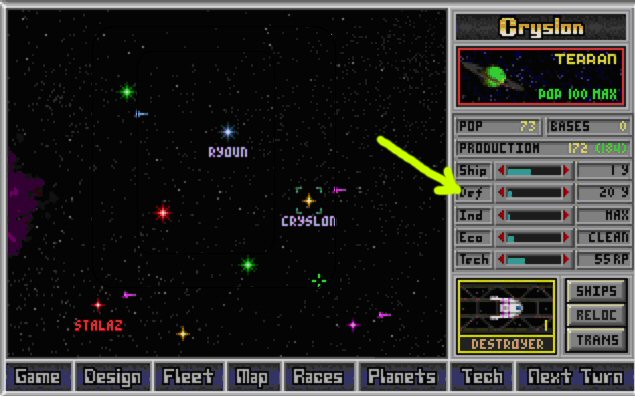
- Master of Orion main game page (production sliders)
Planet size determines the amount of population it may hold, and more population means more production. The Planet’s mineral quality has also a dramatic effect on production in terms of bonuses. The categories vary from: Ultra-poor, Poor, Normal, Rich and Ultra-Rich. And since everything in MOO is about production, planet quality is one, if not the most critical factor for success. Own the richer and bigger planets and you will be the ultimate power of the galaxy and the source of envy of your neighbors.
In MOO there is no tax concept and money can only be made by scrapping ships and bases or by diverting some production to empire reserves as explained above. Players pay maintenance for ships, spies, security and missile bases. This payment is not made from empire reserves but discounted directly from planetary production.
Master of Orion II: specialized economy; adds food and taxes
In MOO2, production is also a direct function of population but now it’s not generated uniformly and not spread into several investment categories: Ships, Defense, Industry, Ecology and Technology as in its predecessor MOO. In MOO2 the player can specialize into three main fields of labor: – food production, industry output and research on a planetary basis. For every million colonists there is one work unit and the player may distribute them among these three economy fields.
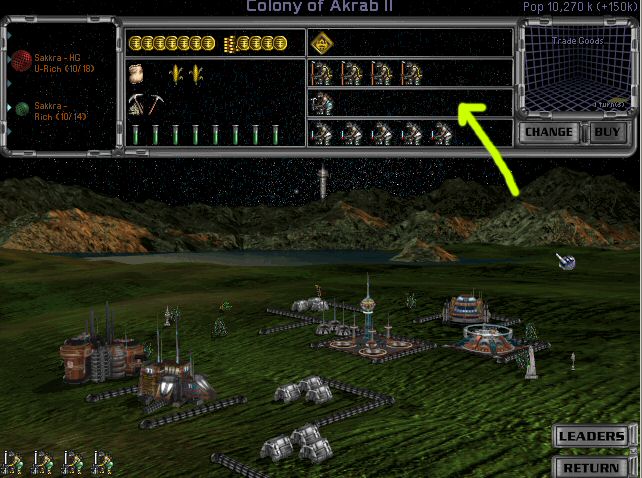
- Master of Orion 2 colony screen (labor allocation)
The food production introduces new a level of complexity in MOO2 economics since now the player has to worry that people don’t starve to death. The industry output is used to build any type of structure being it defense, ships or buildings; research directly contributes to the amount of production diverted to technology.
The main difference from MOO is the inclusion of a colony management system which allows the construction of buildings that affect production through bonus. As an example, the “Rob Miners Plant” building increases the base production of the planet by 10 and the production output of each population unit to +2. The planets quality remains a critical factor in MOO2.
In MOO2 there is a somewhat advanced tax concept. All citizens pay taxes (a fixed amount). Additionally the player can set an industry tax (0% to 50%) that halves industry output in favor of cash. Money can be used to accelerate production of buildings or ships and to hire leaders, a new concept in MOO2 – which are specialists that add further bonuses.
Players pay maintenance for ships, freighters (food trade), spies, tribute and leaders. This payment is discounted directly from empire treasury.
Galactic Civilizations II: global empire management with planetary focus; money has a new meaning
The Galactic Civilizations II approach is much different from MOO and MOO2. In the previous titles the economy is founded on top of population (more on MOO) and population and economic buildings (in MOO2). Money exists but is not an essential factor for MOO and MOO2 on building and researching things and is used for more indirect purposes like build-rush and maintenance. In other words, even without money the planets always produce as long as they have population and factories built on them. Industrial output has therefore nothing to do with the player’s economic income.
On the other hand GalCiv2 adds another level of complexity by requiring that production is paid with money. Production is still dependent on economic structures present in the planet (like factories) but this production is only potential production. To actually build and research stuff the player must allocate money from the global empire budget. Population does not contribute directly to production but indirectly through taxes. More population means more taxes a stronger economy and therefore more money can be spent on actual production.
As said above the player allocates money from the empire budget. It can do so into three areas using sliders that GalCiv2 calls: Social, Military and Research (you can see this in the picture below). By allocating money to the first (Social) the player diverts production to build all sorts of non-military buildings like factories, laboratories, space port, wonders etc. By focusing on the second area (Military) the player allocates production for building spaceships, the third (Research) allocates production to generate research points to investigate new technologies. Actual production is managed on an empire scale so if the player wants to build more social structures in the empire it puts more emphasis on the Social slider.
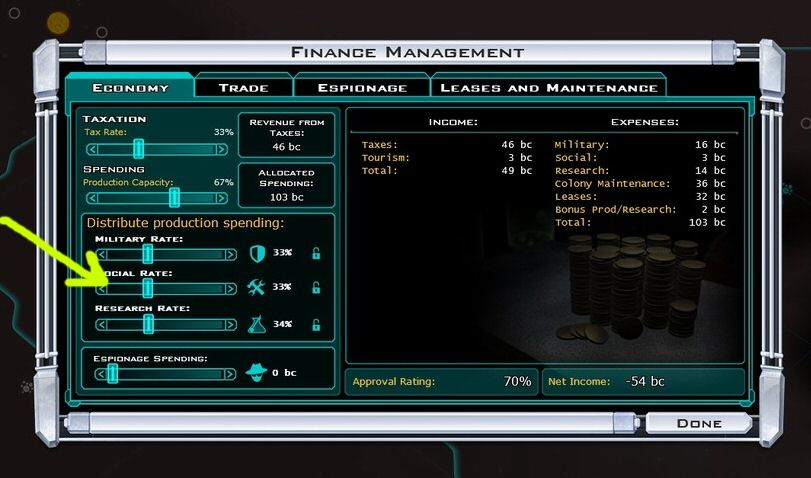
- Galactic Civilizations 2 empire budget allocation sliders
The pros and cons of this economic decision are clear. To alleviate the burden of planetary micromanagement, GalCiv2 developers decided to manage production on an empire scale in direct contrast with MOO and MOO2 where production was managed on a planetary basis. On the reverse side of the coin this caused some problems to gamers that liked to micromanage their planets. In one of the GalCiv2 expansions (Dark Avatar if I recall correctly) they blend the concept by introducing the “planet production focus” concept. In addition to the global empire sliders the players can now focus production on a planetary scale. As an example a player may decide to focus on Research on a global empire scale but decide to focus production on a particular planet for building spaceships and another planet to build social structures. This decision seemed to work because it brought a certain balance to the issue of planet management VS global empire management; at least I was happy with what they did.
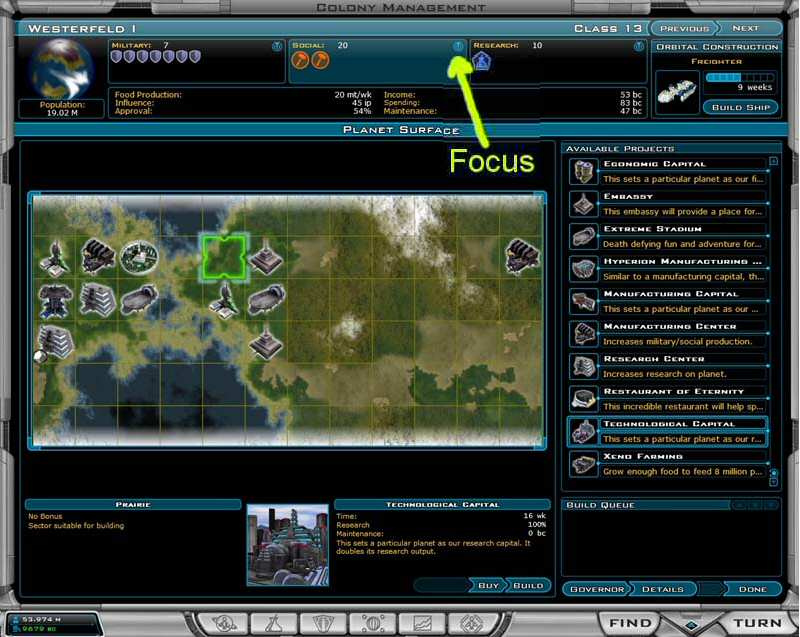
- Galactic Civilizations 2 colony production focus
The player can set taxes but only at an empire scale. More taxes means more money in the short term however the player must pay close attention so that the planets Morale does not get down from a certain level which in the long run will halve income. Money is used for everything: for production, to pay maintenance, tributes and to hurry buildings.
Sword of the Stars: return to local planetary management;
I don’t have so much in depth experience with SOTS as I do with the former titles since I’m not playing it for so much time yet (see what I meant with the “not noticing how economy works” so fast when I introduced this post?) so please correct me if you find any inaccuracies.
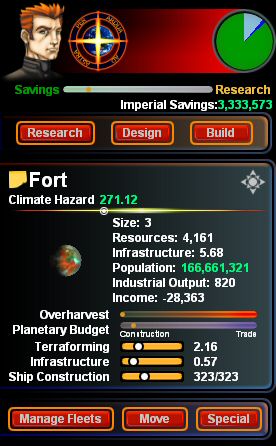
- Sword of the Stars planetary production allocation
Having said this, SOTS presents a similar economy model as the original Master of Orion at least in what concerns local planetary management, the production scheme, the use of sliders to allocate production and the lack of colony city-building.
Production, like in MOO, is a function of both population and “infrastructure”: the SOTS designation for industrial output (or factories). Income comes in direct function of population, what is inferred to be due to taxation. There is no food concept in SOTS, as there was none also on MOO. The planetary budget (production) can be allocated to Trade, Terraforming, Infrastructure and Ship construction. Notice the resemblance with the MOO model where the player diverted production to Ecology (Terraforming), Industry (Infrastructure) and Ships (Ship construction). The Trade slider is new though since SOTS presents a clear separation between money (income) and production as MOO2 and GalCiv2 do.
Money is used to pay maintenance but primarily to spend on Research and cannot be used to hurry production in direct contrast with MOO2 and GalCiv2. In addition to this, SOTS does not offer a refined taxation concept, the player cannot set taxes.
Conclusions
After having dissecting these four classics economic models let’s see in what they agree on and where they go apart. After that let’s try to answer some questions here. First the summary:
MOO:
- Production as a function of population, factories and planet quality
- Production is managed on a planetary basis
- No planetary city-building offered (no economic structures)
- Research is made by allocating global production
- Cannot set taxes
- Money is made by diverting production to empire reserves or by scrapping structures
- Money is used for empire security or to increase production in a planet with penalty
- Maintenance paid directly from planetary production
MOO2:
- Production is a function of population, economic structures (which includes factories), race traits and planet quality
- Production is managed on a planetary basis
- Offers planetary city-building features
- Research is made by allocating population to science (similar to MOO)
- Can set taxes at an empire scale (halves construction in favor of cash)
- Money is made from taxes, by constructing “trade goods” or by scrapping structures and can be used to hurry-buildings
- Money is used to accelerate buildings and ships construction and to hire leaders
- Maintenance is paid directly from empire treasury
GalCiv2:
- Production is a function of economic structures, planetary bonuses (planet quality), trait bonuses and funds allocation
- Production is managed on a global empire basis (with local planetary focus)
- Has planetary city-building
- Research is made using economic structures (labs) and by allocating funds
- Can set taxes at an empire scale (affects morale)
- Money is made primarily from taxes (from population) and trade
- Money is used to create production (buildings, ships and research)
- Maintenance is paid directly from empire treasury
SOTS:
- Production is a function of population and the level of infrastructure
- Production is managed on a planetary basis
- No planetary city-building (no economic structures)
- Research is made solely by allocating funds
- Cannot set taxes (fixed amount)
- Money is made from taxes and trade
- Money is used essentially for research
- Maintenance is paid directly from empire treasury
In conclusion there is one thing where all these games seem to agree on that is the notion that production shall outcome in one way or another from the amount of population present in the planet (the workforce) and the infrastructure level, being it the amount of factories or other economic structures. Only GalCiv2 deviates a bit from this concept. No matter the amount of population you have in a planet the only thing that matters in GalCiv2 is the amount of factories and the amount of money pumped from the empire budget to make them work. This does not seem to be very realistic at first because normally one may think that the more population you have the more production the planet should output. But in another hand one may think that it is not the amount of population or workforce that is important but the amount of infrastructure automation the planet has achieved. One has not to forget though that if you have no people to pay taxes you will not survive in the long run anyway, so the amount of population is kept as a crucial factor for success in GalCiv2 economy model.
Another interesting aspect where the four games this time don’t agree on has to do with research. In MOO and MOO2 research is just another area where the player can allocate production on and in this case it does not have anything to do with money. On the other hand, GalCiv2 and SOTS finance research directly with money. For these last two cases it does not matter that you have lots of labs and lots of population, if you don’t have money to finance research you will not be able to investigate new technologies, which in my opinion is realistic and makes perfect sense.
Than there are a series of other indirect factors in more or less amount depending on the game that affect the game economy. Usually they come in the form of positive or negative bonuses like race traits, empire bonuses, planetary quality, economic structures, morale, etc. These factors contribute in my opinion to the complexity of the economy model but not necessarily to the overall game enjoyment. MOO2 and GalCiv2 provide city-building features that allow players to build all sorts of economic, social or military structures on it. On the other hand MOO and SOTS do not offer this possibility which may frustrate the player avid for planetary micromanagement however it may fancy the players that like to focus more on other areas like spaceship design, research, and battles or like to manage from the “big chair” rather than focus too much attention to planet details.
As final conclusion of this little essay I say that the core of space game economics is normally common ground. The differences are on the details and where the game tends to focus more. Some players like the complexity others enjoy higher abstraction. So for me there is no ideal space game economy model but just one that works and that is ultimately fun to play. But if I would need to pick one I would choose GalCiv2’s model since it is the one that provides the right amount of balance: the player manages production in a global scale but can make small adjustments on a planetary basis.

3 Comments
Related Articles:
- Armada 2526 – New 4x space strategy game – First Impressions
- Pandora: First Contact Beta Preview
- Sword of the Stars 2 Announced
- Interview: Round 2 with Novacore on Legends of Pegasus
- Master of Orion 2: The Formula behind the Success







I don’t even know how I ended up here, but I thought this post was good. I do not know who you are but definitely you are going to a famous blogger if you are not already ;) Cheers!
The economy of Galciv II is ridiculous.
You can fill all your planets with factories and have them all produce at 100%, or you can fill all your planets with labs and have them all produce at 100%.
But if you have a mix of labs and factories, there is no way to avoid having some of them idle even if you have enough cash to pay for 100% production. It makes no sense.
GalCiv II economy does have some shortcomings. I particularly dislike the concept of production not being linked to the population of a planet.
From post above “No matter the amount of population you have in a planet the only thing that matters in GalCiv2 is the amount of factories and the amount of money pumped from the empire budget to make them work. This does not seem to be very realistic”